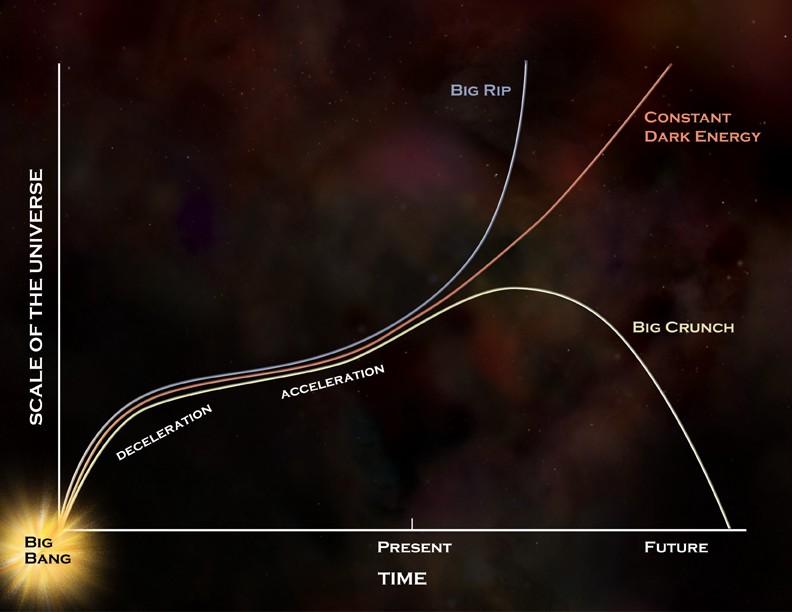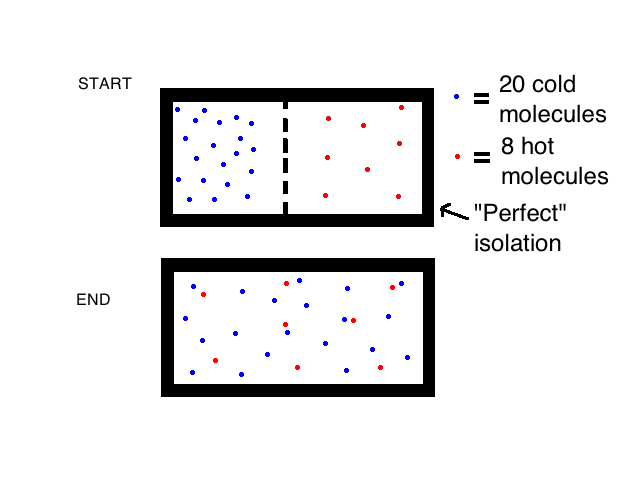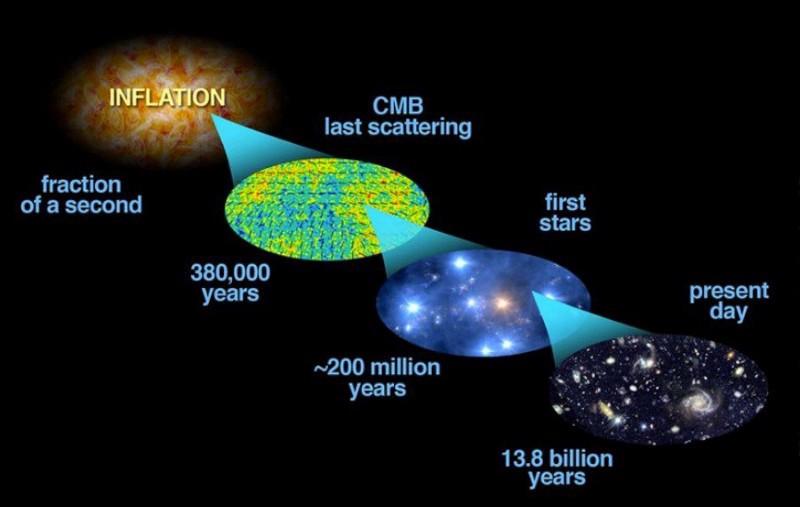Ask Ethan: Could the Universe begin with a Big Rebound?
- Transfer

The “Big Rebound” requires a phase of repeated collapse, followed by a phase of expansion.
Thanks to the progress of science over the past hundred years, we have been able to establish the origin of the Universe, the reasons for its current state and its fate in the distant future. But our knowledge also has limitations: how far into the past we can look, and how far the future future of the evolution of the Universe we can predict with a certain degree of certainty. Beyond these limits are the greatest mysteries. Our reader asks about one of these puzzles:
I read your post about the thermal death of the Universe , and I wondered what you think about the Big Bounce theory .
The answer to this question consists of three parts: what we know, what is considered possible, and what we consider the most probable (for compelling reasons).

The clustering scheme that the galaxies in our Universe
strive for. Our Universe is currently filled with stars, galaxies, black holes, dark matter, dark energy and radiation. It contains both clusters and crowds of matter, and giant voids(emptiness). It expands, cools, and it has a certain number of particles organized in a certain way at any given time. Based on our knowledge of its composition, its expansion, and the laws of physics, we can extrapolate the state of the Universe to both the past and the future. Going into the past, we find that it was more uniform, hot, dense, less clumping, more energetic and uniform. Going into the future, we see that it freezes, becomes empty, becomes more crumpled, sparse, less energetic. We know this with great accuracy.

Since the hot Big Bang, our Universe has undergone tremendous growth and evolution, and continues to do so.
To look at it from the other side, we can turn to the entropy of the visible part of the Universe. The concept of entropy is quite difficult to understand; you can imagine it like this: this is the number of possible ways in which you can form the state of a particular system. Today we can calculate the entropy of the Universe and get a number of the order of 10 104 k, where k is the Boltzmann constant . This amount is mainly composed of supermassive black holes in the centers of galaxies; for example, the entropy of a supermassive black hole alone in the center of the Milky Way is 10 91k. In the early stages of the Universe, these black holes did not exist (they have not yet formed), so its entropy was much less. In the distant future, the Universe will reach even greater values of entropy when they all decay due to Hawking radiation (until this happens). When radiation prevailed in the Universe, about 13.8 billion years ago, its entropy was only 10 88 k. When the last black hole decays in the distant future, the entropy will take the value 10 123 k. The laws of thermodynamics, according to which entropy always grows, correspond to what is happening with the universe.

There are several options for the distant future of the universe; but if, as our data say, dark energy is really constant, then it will continue to develop along the red curve.
What about the features? In the future, the Universe will forever expand, accelerate, but may also experience a break, make a tunnel transition to a new quantum state, or recollapse into a singularity. In the past, it could exist in an inflationary state before the hot Big Bang (in a state with even lower entropy, of the order of 10 15 k), but we do not know anything about the period that lasted until the time 10 -33 s from the beginning of the Universe. Did she have a single beginning in which space and time arose? Or have they always existed? At the annual meeting of the American Astronomical Society, cosmologist Sean Carroll described in great detail the four possibilities for the origin of the universe, which did not originate in a singularity.

In the classical general theory of relativity, it is difficult to avoid singularities. But in quantum theories of gravity, for example, allowing the existence of additional dimensions, options for a rebound are possible.
1. String rebound. In general relativity, extrapolating to the past to a state with an arbitrarily high temperature, high density or small size, you inevitably come to a singularity, and all definitions of time and space cease to work. But in quantum extensions of general relativity, for example, loop quantum gravity , string theory or brane cosmology , one can also “bounce” from the previous contracting state into a hot, dense and expanding one.
2. Cyclic cosmology.It looks like a string rebound, only in this version the rebounds occur constantly. The Universe is expanding, reaching its maximum size, contracting - while all this time the entropy has been growing - and then recollapses, and then bounces again.
3. Cosmological hibernation. Instead of the rapid expansion that our Universe demonstrates today or showed during the period of inflation, the Universe could for a long time be in an approximately constant state of rest. This requires something exotic, such as degravity (when gravity is temporarily disabled), or string gas cosmology.
4. Cosmological reproduction.In this case, the Universe is generated by the previous space-time, which has many options for location and properties, but which did not begin with a singularity. In this case, one of the offspring grows into our universe.

A huge number of sites where the Big Bangs took place are divided by an ever-expanding space in the eternal inflation phase. The
possibility of a Big Bounce is definitely to be considered, and many are engaged in it. But she has a big problem, as with the options 1, 2 and 3 described above: our Universe should have been born with low entropy, and the second law of thermodynamicsno one has canceled. Either in the past, the entropy of the Universe decreased, which would be the greatest violation of the second law of thermodynamics, or in the past, the entropy was even less - fine-tuned so as to be practically zero.
In the first variant - a string bounce - entropy should decrease. In cyclical bounces, entropy should always increase. This means that in the last cycle, preceding the rebound, there should be even less entropy than it was at the birth of our universe; that in this cycle the entropy has grown, and that the next bounce will begin with an even greater value of entropy than with which our Universe will end. And of all these scenarios, only the fourth avoids entropy problems. To understand how this works, imagine that the Universe is in a state with great entropy, with a lot of variations and fluctuations.

Particles in the diagram below will very rarely go into the state shown above, but small fluctuations, or entropy drops, are quite possible
This is a fairly universal condition; this is the least accurately adjusted initial state from which you can start counting, and it also has a lot in common with most physical systems that you can imagine - for example, with a room filled with gas molecules at a relatively high temperature. You cannot expect all the molecules to be in one half of the room at the same time, and the other will remain empty. This option is not only less preferred from the point of view of thermodynamics, but also extremely unlikely from the point of view of statistics. But you would not be surprised that if in a fist-sized section there would be several billion more or fewer molecules than the average, or if it had a little more (or less) energy or entropy than the average. If we confine ourselves to the study of very small areas with, say, the size of the order of the virus (and they are 5 nm in size), you can find a site with extremely low or even negligible entropy. The total entropy of the system should still grow, but a very small area can have very small, even negligible, entropy at any given time.

Although inflation can end in more than 50% of the plots at any given time (indicated by red X), a sufficient number of regions will continue to expand forever and inflation will last forever, with no two Universes ever colliding.
It is possible that tiny plots with fluctuations, where entropy decreases quite strongly; they can give rise to a new universe where inflation is occurring.

Inflation led to the Big Bang and the observable Universe, to which we have access, but fluctuations that occurred during inflation have grown in existing structures today
Inflation has such an amazing property - when it begins, it creates more and more space with an amazingly high speed, and it continues to grow exponentially. There are areas in which inflation will end and give rise to the hot Big Bang, and space filled with matter, antimatter and radiation, such as our observable Universe. But there are areas that will continue to expand. The Universe could begin with a singularity, when space and time appeared from a state that had neither space nor time outside (how much the concepts “appeared” and “outside” can be used in the absence of space and time), but it could also appear out of singularity. However, while we have the second law of thermodynamics, that is, while the total entropy of the system cannot decrease, the ideas of the “big rebound” are hindered by a very big obstacle. The lack of evidence of recollapse, together with the theoretical difficulties faced by the bounce option, the best that physics can offer to describe the birth of the Universe is a variant with reproduction.
Ethan Siegel - astrophysicist, science popularizer, author of the Starts With A Bang! He wrote the books “Beyond the Galaxy” [ Beyond The Galaxy ], and “Tracknology: the science of Star Trek” [ Treknology ].
